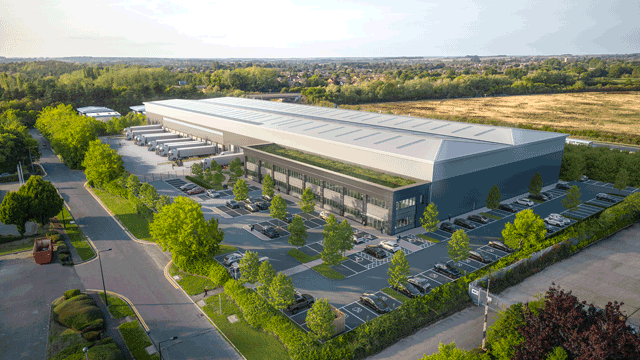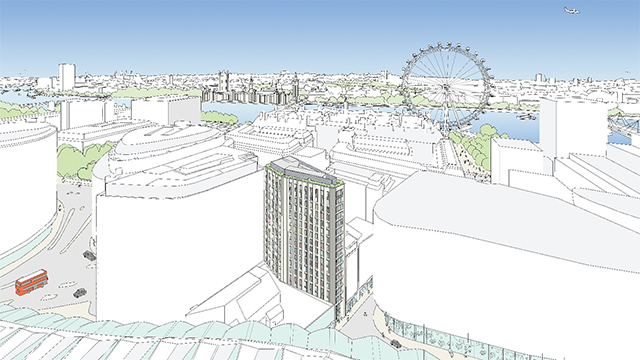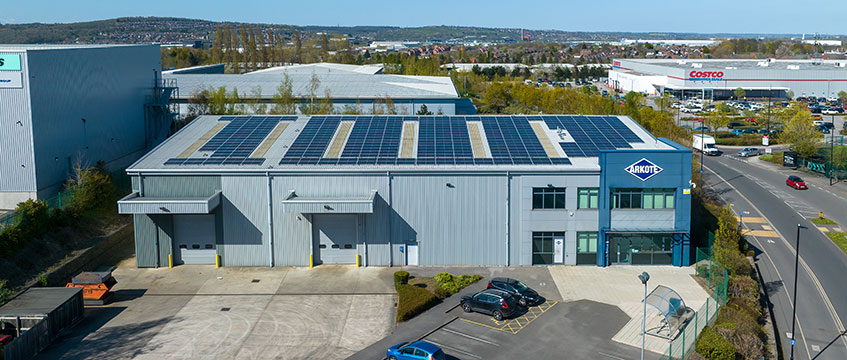South Wales has had industrial closures before and bounced back, but to attract investment more spec development is needed. David Thame reports
Some days you’re up, others you’re down. The day earlier this month that Anglo-Dutch steel manufacturer Corus announced that 2,800 jobs were to go at its plants in Ebbw Vale and Llanwern was definitely a downer. Yet 24 hours later, motor giant Ford announced a £240m investment in a new engine line at its Bridgend plant. The move will create 500 jobs and secure the plant’s future for another 25 years.
The latest developments follow a roller-coaster year or two for the South Wales industrial sector. The tide of inward investment from South East Asia, which buoyed up the market for more than a decade, has ebbed. Panasonic shed 1,300 jobs and Sony and Hitachi also made big cuts, preferring to reinvest in Eastern Europe.
Textile companies and clothing businesses such as Fiona Footwear have also closed facilities. Electroics firm Lucky Goldstar’s investment did not turn out as planned while some – like PCmanufacturer Acer – never arrived despite plans to invest.
A rescue package – and a support plan in case a rescue fails – are now being pieced together by Welsh First Minister Rhodri Morgan and the Welsh Development Agency. Even so, aggrieved steelworkers are now threatening to blockade Corus’s Welsh plants. And many in the local property market are far from unsympathetic to their cause.
John Jones at GVA Grimley says: “Six to 12 months down the line and the Corus decision is going to start to make a difference to the economy and the property market. We have a lot of tenants who service the plants at Ebbw Vale and Llanwern, and by then they could be struggling or out of business.”
Despite the obvious difficulties ahead, few market observers are prepared to write off the likelihood of a good recovery. As Rhys Morgan, industrial specialist with Knight Frank, remarks: “We’ve had industrial closures before and bounced back. If the Welsh Development Agency gets the public-sector help it needs, and if we can secure private investment, especially in the hi-tech sector, the position is recoverable.”
And so, say the optimists, South Wales will bounce back. They point to the experience of Ebbw Vale itself where, 10 years ago, the Rassa Estate, Tredegar, was built to satisfy local leaders that the WDA had the valley’s interests at heart.
Estate could have role to play
The estate could now find itself in the right place at the right time, according to Simon Lloyd, industrial specialist with DTZ Debenham Tie Leung. If the estate can play a role in the WDA’s plans to boost local industry, Lloyd says, his client – landlord Sandringham Investments – would be happy to help.
“The estate has some good, modern manufacturing facilities. The WDA needs to act quickly to take advantage of opportunities in the area to make up for the Corus job losses, and maybe the Sandringham property there could help,” explains Lloyd.
“Clearly the Corus decision isn’t going to help raise economic expectations. But I think the closure decision was probably inevitable,” he adds.
The hope is that the WDA and the National Assembly can use new EU funding to stem the flow of jobs out of South Wales. Since 1 January last year, much of the region – especially the valleys – qualifies for EU funding under the Objective 1 and 2 programmes.
Chesterton’s Michael Bruce says: “Plans have been submitted to improve transport links in certain parts of the region, and a number of land-reclamation schemes have provided more development sites.
“If the economic events of the past year are repeated, then 2001 could prove to be yet another difficult period in the property market. However, the combination of the availability of Objective 1 funding, and the forward-looking approaches being adopted by the WDA, National Assembly and local authorities, could all serve to create improved trading conditions.”
The private-sector element in the industrial market of south-east Wales remains modest. The pure industrial market remains dominated by public-sector interests, whether from the WDA or local councils. And the distribution market has not mushroomed in the way it has in England.
That is because the local markets are not so large as in English provincial cities and their distribution requirements can be serviced from Bristol. While some distributors have crossed the Severn – Wilkinsons, for example, chose Broadhall/Morrisons’ Gwent Euro Park for a 79,000m2 (850,000 sq ft) depot – the market remains limited.
According to DTZ’s Lloyd: “We have almost no distribution market. There is not much new development, and very little speculative development. I’ve seen only a handful of major speculative schemes in recent years.”
Not everyone entirely shares Lloyd’s view. Even so, the mood differs little among agents throughout south-east Wales.
“The private sector is a bit wary and prefers waiting for prelets. But while rents are hovering around £3.50-£4 per sq ft in Newport, it doesn’t justify speculative development,” says Richard Hutchings, senior partner with Newport agent Hutchings & Thomas.
And David Cochlin, director at Cooke & Arkwright, adds: “Liberty, Green, JR Smart – they have all built something, but they haven’t let as well as people thought they would.”
Obsolete stock increasing
Research by King Sturge suggests that new speculative development is needed urgently. The firm’s Chris Sutton says: “There is 8.25m sq ft of industrial floorspace available from a total of 180m sq ft. This has been fairly constant for some time but the proportion of obsolete stock is increasing.”
He is among those hoping that the WDA will step in to provide new supply.
The WDA admits that supply is thin, in both the public and the private sectors. It points to the 9,290m2 (100,000 sq ft) EU-funded scheme at Goatmill Road, Merthyr Tydfil, and to schemes around Caerphilly. But, concedes a spokesperson: “We know there is very little speculative development, which is why we are seeking funding from the National Assembly for around 150,000 sq ft of speculative development around south-east Wales.”
Local developers – as is often the case – have led the way in these doubtful conditions. Cardiff-based JR Smart moved into the industrial market with a series of speculative schemes named after the points of the compass.
South Point, an 8,361m2 (90,000 sq ft) scheme at Foreshore Road close to Cardiff Bay, follows on from West and East Points where small- and medium-sized units have let well. Rents being quoted on South Point are about £57 per m2 (£5.25 per sq ft), say letting agents DTZ Debenham Tie Leung and Fletcher Morgan. The market awaits the inevitable North Point scheme with bated breath.
But big-name developers are scarce. Two that are active in the region are Green Property, at work at the Trefforest Industrial Estate, and Land Securities which has Neptune Point.
At Neptune Point, 5,574m2 (60,000 sq ft) has been built and there is room for another 9,290m2 (100,000 sq ft). DTZ’s Lloyd, adviser to Land Securities on the scheme, admits: “The market has not been as vibrant as we had hoped, and everyone could be happier. We would have liked to see more procurement from occupiers outside the public sector.”
Some mutter, however, that the rents being quoted – £59 per m2 (£5.50 per sq ft) – might be proving a stumbling block, too.
The supply of buildings may be erratic, according to some observers, but land supply is not a problem. Nor is it likely to become one in the short or medium term.
Motor giant Ford has been promoting the Waterton Park site at Bridgend with joint developers Glasgow-based Bett Properties and London-based bloc.
The £240m investment in the production of duratec engines – now used in the Mondeo and soon to be used elsewhere in the range – will absorb some land. But 22.6ha (56 acres) is available for alternative uses.
Retail in demand
A recent 7.2ha (18 acre) deal on the site with discount food retailer Lidl – which will be constructing a 32,515m2 (350,000 sq ft) warehouse to serve 28 local stores – proves that private-sector demand is still present.
Closer to Cardiff, Wentloog is becoming a focus for development. Located to the south-east of the city, Wentloog’s attractions do not lie on the surface. A moonscape of fields and industrial clutter cling to the muddy banks of the River Rhymney – it is not a pretty place.
However, long-projected improvements to the road network will improve connections with the M4 corridor – and with the city and bay areas. And the new £15m rail freight terminal will massively enhance Wentloog’s credentials, as well as releasing for redevelopment the old site on Newport Road.
There are already sites prepared at Wentloog, including Capital Business Park and the food and technology park, developed by Portfolio Holdings and Cardiff city council.
David Mullins, partner with Fletcher Morgan, joint letting agent on the Capital scheme, says that a 4,645m2 (50,000 sq ft) speculative industrial scheme will start on site in June. There are also some big land sales coming up, he says.
A second site, the 24.2ha (60 acre) former Arjo Wiggins papermaking site, 3km west of the city centre around Cowbridge Road and Longbridge Road, is also attracting interest. It was recently acquired by the WDA for a sum believed to be in the region of £11.6m in the face of stiff competition from private-sector bidders. Opinions are divided over whether this was a praiseworthy intervention in the free market by the WDA.
Market speculation is also rife on the site’s future use: a mixed scheme involving a residential element is strongly tipped by disappointed industrial agents. But all will soon be revealed, as the WDA says an announcement is imminent.
|
New industrial premises on the market Table 1 |
|||
|
The WDA is seeking funding from the National Assembly to bolster speculative development |
|||
|
Address |
Size (m2) |
Rent (£ per m2) |
Developer |
|
Neptune Point, phase one, Cardiff |
2 x 1,936 |
60 |
Land Securities/Liberty Properties |
|
Neptune Point, phase two, Cardiff |
465-8,360 |
60 |
Land Securities/Liberty Properties |
|
St Catherines Park, Cardiff |
678-1,386 |
51 |
Rightacres Properties |
|
South Point, Cardiff |
300-3,250 |
60 |
JR Smart Builders |
|
Canal Industrial Park, Cardiff |
293-441 |
53 |
Bute Property Services |
|
Quay Point, Cardiff |
855 |
64 |
Support site |
|
Denvale Trade Park, Cardiff |
292-5,254 |
92 |
Denvale Trade Parks |
|
Cardiff Food Park |
3 x 240 |
54 |
Cardiff county council |
|
Forest Court, Treforest |
659-3,860 |
59 |
Green Property |
|
Oakdale Business Park, Caerphilly council |
1,858-3,716 |
41 |
WDA/Caerphilly county borough |
|
Goatmill Road, Merthyr Tydfil |
1,507-4,722 |
43 |
WDA |
|
Severnbridge Industrial Estate |
604 |
44 |
Beacons Estates |
|
Baglan Energy Park, Port Talbot |
3,715 |
n/a |
BP/WDA/NeathPT CBC |
|
Source: Cooke & Arkwright Research (See also Table 2, p110) |
|||
|
Development sites Table 2 |
|||
|
Research shows that new spec-build development is urgently needed |
|||
|
Address |
Size (ha) |
Assisted area status |
Owner/developer |
|
Capital Business Park, Cardiff |
30.8 |
C |
Portfolio Holdings/Cardiff county council |
|
Pacific Business Park, Cardiff |
3.7 |
C |
Hollybush Properties |
|
Wentloog Corporate Park, Cardiff |
23.3 |
C |
Euroclad |
|
Airport Business Park, Rhoose |
45.7 |
None |
Vale of Glamorgan CBC/TBI |
|
Celtic Springs, Newport |
18.2 |
C |
Morrison/Broadhall |
|
Cleppa Park IV, Newport |
4.9 |
C |
Robert Hitchins Properties |
|
Pencoed Triangle, Bridgend |
13.6 |
A |
Macob |
|
Island Farm, Bridgend |
26.0 |
A |
Bridgend county borough council |
|
Brocastle Farm, Bridgend |
32.5 |
A |
WDA |
|
Land adjacent Ford, Bridgend |
10.9 |
A |
Ford |
|
Baglan Energy Park, Port Talbot |
16.6 |
A |
BP/WDA/NeathPT CBC |
|
Matrix Park, Swansea |
4.9 |
A |
Liberty Properties |
|
Swansea Vale |
10.9 |
A |
City & County of Swansea |
|
Rassa, Ebbw Vale |
9.6 |
A |
Mixed ownership |
|
Oakdale Business Park, Caerphilly |
20.2 |
A |
Caerphilly county borough council |
|
East Merthyr, Merthyr Tydfil |
11.7 |
A |
Merthyr Tydfil county borough council |
|
Parc Eirin, Tonyrefail |
24.2 |
A |
WDA/Brunswick |
|
Mamhilad Technology Park, Pontypool |
9.2 |
A |
WDA |
|
Newhouse Park, Chepstow |
7.5 |
None |
Eastmon Industrial Holdings |
|
Gwent Euro Park |
7.1 |
C |
Morrison Developments |
|
Cooke & Arkwright carries out an annual survey of the performance of the various property sectors across South Wales. The figures this year show that vacant industrial space has fallen by 2%. Some speculative building has been taking place and newly built, vacant premises are listed in Table 1 together with quoted rents. Heather Robinson, research department head, says that the interesting aspect to monitor this year will be the effect of the new grant systems for Wales on both the supply of new buildings and the take-up of development land. West Wales and the Valleys can now progress projects supported by Objective One funding and this, together with the new map for Regional Selective Assistance, should boost employment land take. Table 2 shows a selection of sites which can be developed in the short-term and the grant status which may apply. Areas covered by Objective One are also derogation A areas for RSA. In these areas the overal level of grant (from all sources) cannot exceed 35% of capital costs. In areas designated as derogation C, grant aid cannot exceed 15% of capital costs – except in Powys where the limit is 20%. |
|||
|
Source: Cooke & Arkwright Research |
|||










